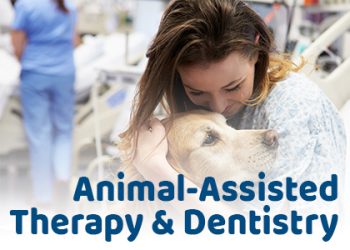Animal-Assisted Therapy & Dentistry
 Assistance animals prescribed for many different conditions and situations have become a frequent topic of discussion in recent years.
Assistance animals prescribed for many different conditions and situations have become a frequent topic of discussion in recent years.
Under the Americans with Disabilities Act, many businesses must allow service animals to accompany disabled individuals into any public area of a facility. For example, a hospital would allow the presence of a service animal in exam rooms, patient rooms, clinics, and cafeterias, but not necessarily in an operating room or burn unit where a sterile environment could be compromised.
Studies have shown AAT’s effectiveness in lowering blood pressure and improving mood. Hospitals, mental health therapy, and eldercare facilities currently employ AAT as a matter of course, but assistance animals are much less common in dentistry. Early research shows a correlation between AAT and stress reduction in populations that range from the elderly to children with different cognitive abilities.
Incorporating AAT encourages patients to focus on the therapy animal rather than their own symptoms or pain. However, AAT in dentistry carries risks such as allergies, fear of animals, and infection concerns. Guidelines for the use of AAT have been outlined by the Society for Healthcare Epidemiology (SHEA), while training standards have been set by Pet Partners. Additional guidelines are also recommended by the American Veterinary Association.
If you want to discuss AAT with Dr. Sepich at Saxonburg Dental Care, don’t hesitate to get in touch.
The content of this blog is not intended to be a substitute for professional medical advice, diagnosis, or treatment. Always seek the advice of qualified health providers with questions you may have regarding medical conditions.
